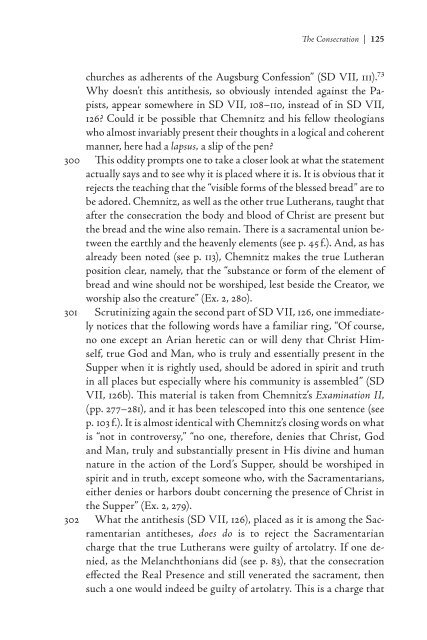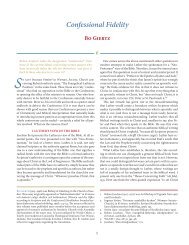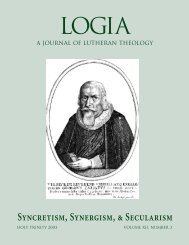The Lord's Supper in the Theology of Martin Chemnitz Bjarne - Logia
The Lord's Supper in the Theology of Martin Chemnitz Bjarne - Logia
The Lord's Supper in the Theology of Martin Chemnitz Bjarne - Logia
You also want an ePaper? Increase the reach of your titles
YUMPU automatically turns print PDFs into web optimized ePapers that Google loves.
<strong>The</strong> Consecration |<br />
churches as adherents <strong>of</strong> <strong>the</strong> Augsburg Confession” (SD VII, 111). 73<br />
Why doesn’t this anti<strong>the</strong>sis, so obviously <strong>in</strong>tended aga<strong>in</strong>st <strong>the</strong> Papists,<br />
appear somewhere <strong>in</strong> SD VII, 108–110, <strong>in</strong>stead <strong>of</strong> <strong>in</strong> SD VII,<br />
126? Could it be possible that <strong>Chemnitz</strong> and his fellow <strong>the</strong>ologians<br />
who almost <strong>in</strong>variably present <strong>the</strong>ir thoughts <strong>in</strong> a logical and coherent<br />
manner, here had a lapsus, a slip <strong>of</strong> <strong>the</strong> pen?<br />
300 This oddity prompts one to take a closer look at what <strong>the</strong> statement<br />
actually says and to see why it is placed where it is. It is obvious that it<br />
rejects <strong>the</strong> teach<strong>in</strong>g that <strong>the</strong> “visible forms <strong>of</strong> <strong>the</strong> blessed bread” are to<br />
be adored. <strong>Chemnitz</strong>, as well as <strong>the</strong> o<strong>the</strong>r true Lu<strong>the</strong>rans, taught that<br />
after <strong>the</strong> consecration <strong>the</strong> body and blood <strong>of</strong> Christ are present but<br />
<strong>the</strong> bread and <strong>the</strong> w<strong>in</strong>e also rema<strong>in</strong>. <strong>The</strong>re is a sacramental union between<br />
<strong>the</strong> earthly and <strong>the</strong> heavenly elements (see p. 45 f.). And, as has<br />
already been noted (see p. 113), <strong>Chemnitz</strong> makes <strong>the</strong> true Lu<strong>the</strong>ran<br />
position clear, namely, that <strong>the</strong> “substance or form <strong>of</strong> <strong>the</strong> element <strong>of</strong><br />
bread and w<strong>in</strong>e should not be worshiped, lest beside <strong>the</strong> Creator, we<br />
worship also <strong>the</strong> creature” (Ex. 2, 280).<br />
301 Scrut<strong>in</strong>iz<strong>in</strong>g aga<strong>in</strong> <strong>the</strong> second part <strong>of</strong> SD VII, 126, one immediately<br />
notices that <strong>the</strong> follow<strong>in</strong>g words have a familiar r<strong>in</strong>g, “Of course,<br />
no one except an Arian heretic can or will deny that Christ Himself,<br />
true God and Man, who is truly and essentially present <strong>in</strong> <strong>the</strong><br />
<strong>Supper</strong> when it is rightly used, should be adored <strong>in</strong> spirit and truth<br />
<strong>in</strong> all places but especially where his community is assembled” (SD<br />
VII, 126b). This material is taken from <strong>Chemnitz</strong>’s Exam<strong>in</strong>ation II,<br />
(pp. 277–281), and it has been telescoped <strong>in</strong>to this one sentence (see<br />
p. 103 f.). It is almost identical with <strong>Chemnitz</strong>’s clos<strong>in</strong>g words on what<br />
is “not <strong>in</strong> controversy,” “no one, <strong>the</strong>refore, denies that Christ, God<br />
and Man, truly and substantially present <strong>in</strong> His div<strong>in</strong>e and human<br />
nature <strong>in</strong> <strong>the</strong> action <strong>of</strong> <strong>the</strong> Lord’s <strong>Supper</strong>, should be worshiped <strong>in</strong><br />
spirit and <strong>in</strong> truth, except someone who, with <strong>the</strong> Sacramentarians,<br />
ei<strong>the</strong>r denies or harbors doubt concern<strong>in</strong>g <strong>the</strong> presence <strong>of</strong> Christ <strong>in</strong><br />
<strong>the</strong> <strong>Supper</strong>” (Ex. 2, 279).<br />
302 What <strong>the</strong> anti<strong>the</strong>sis (SD VII, 126), placed as it is among <strong>the</strong> Sacramentarian<br />
anti<strong>the</strong>ses, does do is to reject <strong>the</strong> Sacramentarian<br />
charge that <strong>the</strong> true Lu<strong>the</strong>rans were guilty <strong>of</strong> artolatry. If one denied,<br />
as <strong>the</strong> Melanchthonians did (see p. 83), that <strong>the</strong> consecration<br />
effected <strong>the</strong> Real Presence and still venerated <strong>the</strong> sacrament, <strong>the</strong>n<br />
such a one would <strong>in</strong>deed be guilty <strong>of</strong> artolatry. This is a charge that




